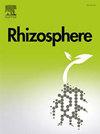Bionematicides shape plant growth-promoting bacteria community in the sugarcane rhizosphere
IF 3.4
3区 生物学
Q1 PLANT SCIENCES
引用次数: 0
Abstract
Monocropping can negatively affect biodiversity and promote the incidence of plant-parasitic nematodes. To mitigate these effects, bionematicides containing microorganisms have been employed as a strategy for nematode control. However, their impact on the community of plant growth-promoting bacteria (PGPB) in the rhizosphere remains poorly understood. This study aimed to evaluate the effects of different bionematicides on the PGPB community in the sugarcane rhizosphere, with Pratylenchus zeae as the target root nematode. A greenhouse experiment was conducted using six microbial formulations with nematicidal properties, containing Bacillus subtilis, Bacillus amyloliquefaciens, Pseudomonas oryzihabitans, Purpureocillium lilacinum, and Bacillus licheniformis. The PGPB community was characterized through 16S rRNA gene amplicon sequencing. Our results revealed that Bacillus and Sphingomonas were the most abundant PGPB taxa in the rhizosphere, regardless of bionematicide application. However, microbial diversity increased following inoculation with P. oryzihabitans and decreased with B. amyloliquefaciens and a multi-strain combination of P. lilacinum, B. subtilis, and B. licheniformis. Niche occupancy analysis indicated a predominance of generalist over specialist PGPB, with P. oryzihabitans favoring the recruitment of specialist taxa. Co-occurrence network analysis showed a stable number of nodes across treatments, while microbial interactions (edges) were highest in the P. oryzihabitans treatment. These findings suggest that bionematicides modulate PGPB diversity and interactions in the sugarcane rhizosphere, with P. oryzihabitans playing a central role in enhancing microbial specialization and network complexity.
生物杀氮剂在甘蔗根际形成促进植物生长的细菌群落
单作会对生物多样性造成负面影响,并增加植物寄生线虫的发病率。为了减轻这些影响,含有微生物的生物杀线虫剂已被用作控制线虫的策略。然而,它们对根际植物生长促进菌(PGPB)群落的影响尚不清楚。本研究旨在评价不同生物杀线虫剂对甘蔗根际pppb群落的影响,以玉米密柄线虫为目标根线虫。采用枯草芽孢杆菌、解淀粉芽孢杆菌、米氏假单胞菌、紫丁香紫色芽孢杆菌和地衣芽孢杆菌6种具有杀线虫特性的微生物制剂进行了温室试验。通过16S rRNA基因扩增子测序对PGPB群落进行了鉴定。结果表明,芽孢杆菌和鞘氨单胞菌是根际最丰富的ppgpb类群,与生物杀氧剂的施用无关。然而,接种稻谷芽孢杆菌后,微生物多样性增加,而接种解淀粉芽孢杆菌和淡紫色芽孢杆菌、枯草芽孢杆菌和地衣芽孢杆菌的多菌株组合后,微生物多样性减少。生态位占有分析表明,通才型植物比专门型植物占优势,稻子茅生境倾向于引进专门型植物。共发生网络分析结果表明,各处理间的节点数稳定,而微生物相互作用(边)在稻谷菌处理中最高。这些发现表明,生物杀氧剂调节了甘蔗根际PGPB的多样性和相互作用,其中米氏p.o yzihabitans在提高微生物专业化和网络复杂性方面发挥了核心作用。
本文章由计算机程序翻译,如有差异,请以英文原文为准。
求助全文
约1分钟内获得全文
求助全文
来源期刊

Rhizosphere
Agricultural and Biological Sciences-Agronomy and Crop Science
CiteScore
5.70
自引率
8.10%
发文量
155
审稿时长
29 days
期刊介绍:
Rhizosphere aims to advance the frontier of our understanding of plant-soil interactions. Rhizosphere is a multidisciplinary journal that publishes research on the interactions between plant roots, soil organisms, nutrients, and water. Except carbon fixation by photosynthesis, plants obtain all other elements primarily from soil through roots.
We are beginning to understand how communications at the rhizosphere, with soil organisms and other plant species, affect root exudates and nutrient uptake. This rapidly evolving subject utilizes molecular biology and genomic tools, food web or community structure manipulations, high performance liquid chromatography, isotopic analysis, diverse spectroscopic analytics, tomography and other microscopy, complex statistical and modeling tools.
 求助内容:
求助内容: 应助结果提醒方式:
应助结果提醒方式:


